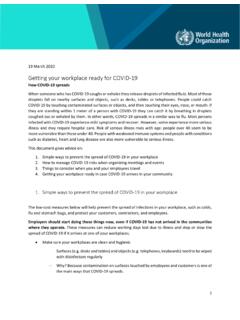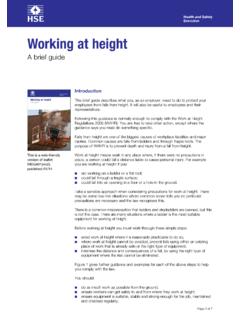Transcription of Health and safety statistics 2021
1 Health and safety at workSummary statistics for Great Britain 2021 Health and safety at work Summary statistics for Great Britain 2021page 2 of 13 Key millionWorkers suffering from work-related ill Health (new or long-standing) in 2020/21 Source: Estimates based on self-reports from the Labour Force Survey, people who worked in the last 12 months Coronavirus PandemicThe coronavirus (COVID-19) pandemic has impacted Health and safety statistics in 2020/21. No new data on working days lost and economic costs is available. However, two new measures have been developed to explore the impact of coronavirus on work-related ill Health in 2020 millionWorkers sustaining a non-fatal injury in 2020/21 Source: Estimates based on self-reports from the Labour Force millionWorkers suffering from work-related stress, depression or anxiety (new or long-standing) in 2020/21 Source: Estimates based on self-reports from the Labour Force Survey, people who worked in the last 12 months93,000 Workers suffering from COVID-19 in 2020/21 which they believe may have been from exposure to coronavirus at work (new or long-standing) Source: Estimates based on self-reports from the Labour Force Survey, people who worked in the last 12 months142 Workers killed at work in 2020/21 Source.
2 MillionWorkers suffering from work-related musculoskeletal disorders (new or longstanding) in 2020/21 Source: Estimates based on self-reports from the Labour Force Survey, people who worked in the last 12 millionWorkers suffering from a work-related illness caused or made worse by the effects of the coronavirus pandemic (new or long-standing) in 2020/21 Source: Estimates based on self-reports from the Labour Force Survey, people who worked in the last 12 months12,000 Lung disease deaths each year estimated to be linked to past exposures at workSource: Counts from death certificates and estimates from epidemiological information, including deaths from mesotheliomaHealth and safety at work Summary statistics for Great Britain 2021page 3 of 13 Work-related ill millionWorkers suffering from work-related ill Health (new or long-standing) in 2020/21850,000 Workers suffering from a new case of work-related ill Health in 2020/2113,000 Deaths each year estimated to be linked to past exposure at work, primarily to chemicals or dustIn the recent years prior to the coronavirus pandemic, the rate of self-reported work-related ill Health had been broadly flat.
3 In 2020/21 the rate was higher than the 2018/19 pre-coronavirus new data on working days lost is available for 2020/21. Data for earlier periods can be found at of ill Health based on Labour Force Survey (LFS) self-reports and deaths based on counts from death certificates and estimates from epidemiological information. To find out the story behind the key figures, visit and long-standing cases of work-related ill Health by type, 2020/21 Work-related ill Health per 100,000 workers: new and long-standing22%Other type of illness28%Musculoskeletal disorders50%Stress, depression or anxiety60005000400030002000100002001/02 2020/21No ill- Health data collected in 2002/03 or 2012/13 represented by a dashed lineShaded area represents a 95% confidence intervalHealth and safety at work Summary statistics for Great Britain 2021page 4 of 13 Work-related stress, depression or anxiety822,000 Workers suffering from work-related stress, depression or anxiety (new or long-standing)
4 In 2020/21451,000 Workers suffering from a new case of work-related stress, depression or anxiety in 2020/21In the recent years prior to the coronavirus pandemic, the rate of self-reported work-related stress, depression or anxiety had shown signs of increasing. In 2020/21 the rate was higher than the 2018/19 pre-coronavirus , lack of support, violence, threats or bullying and changes at work were estimated to be the main causes of work-related stress, depression or anxiety prior to the pandemic based on 2009/10-2011/12 LFS 2020/21 the effects of the coronavirus pandemic were also found to be a major contributory factor to work-related stress, depression or of work-related stress, depression or anxiety based on self-reports from the Labour Force Survey (LFS)To find out the story behind the key figures, visit with higher than average rates of stress, depression or anxiety, averaged 2018/19 2020/21 Stress, depression or anxiety per 100,000 workers.
5 New and long-standingAll industriesPublic admin/defenceEducationHuman Health /social work0 500 1000 1500 2000 2500 3000 3500 Rate per 100,000 workers3000250020001500100050002001/02 2020/21No ill- Health data collected in 2002/03 or 2012/13 represented by a dashed lineShaded area represents a 95% confidence intervalHealth and safety at work Summary statistics for Great Britain 2021page 5 of 13 Work-related musculoskeletal disorders470,000 Workers suffering from work-related musculoskeletal disorders (new or long-standing) in 2020/21162,000 Workers suffering from a new case of work-related musculoskeletal disorder in 2020/21 Prior to the coronavirus pandemic, the rate of self-reported work-related musculoskeletal disorders showed a generally downward trend.
6 In 2020/21 the rate was broadly similar to the 2018/19 pre-coronavirus handling, awkward or tiring positions and keyboard work or repetitive action were estimated to be the main causes of work-related musculoskeletal disorders prior to the pandemic, based on 2009/10-2011/12 LFS 2020/21 the effects of the coronavirus pandemic were also found to be a contributory factor to work-related musculoskeletal of work-related musculoskeletal disorders based on self-reports from the Labour Force Survey (LFS)To find out the story behind the key figures, visit with higher than average rates of musculoskeletal disorders, averaged 2018/19 2020/21 Musculoskeletal disorders per 100,000 workers: new and long-standingMusculoskeletal disorders by affected area, 2020/21 16%Lower limbs (76,000)39%Back (182,000)45%Upper limbs or neck (212,000)
7 All industriesHuman Health and social workConstructionRate per 100,000 workers0 500 1000 1500 2000250020001500100050002001/02 2020/21No ill- Health data collected in 2002/03 or 2012/13 represented by a dashed lineShaded area represents a 95% confidence intervalHealth and safety at work Summary statistics for Great Britain 2021page 6 of 13 Occupational lung disease12,000 Lung disease deaths each year estimated to be linked to past exposures at work2,369 Mesothelioma deaths in 2019, with a similar number of lung cancer deaths linked to past exposures to asbestos17,000 Estimated new cases of breathing or lung problems caused or made worse by work each year on average over the last three years, according to self-reports from the Labour Force SurveyOccupational lung diseases account for around 12,000 of the 13,000 total annual deaths estimated to be linked to past exposures at mesothelioma deaths are expected to reduce over the period 2020 to to the coronavirus pandemic, the rate of annual new cases of occupational asthma seen by chest physicians had been increasing with 174 estimated cases in 2019.
8 To find out the story behind the key figures, visit mesothelioma deaths and future projections to 2030 Lung diseases contributing to estimated current annual deaths3% Other disease20%Asbestos-related lung cancer20%Mesothelioma23%Non-asbestos related lung cancer34%Chronic obstructive pulmonary disease (COPD)3000250020001500100050001980 1990 2000 2010 2020 2030 Mesothelioma deaths Projected deathsShaded area represents the upper and lower prediction intervalHealth and safety at work Summary statistics for Great Britain 2021page 7 of 13 Coronavirus pandemic93,000 Workers suffering with COVID-19 in 2020/21 which they believe may have been from exposure to coronavirus at work (new or long-standing).
9 Around half of those suffering were in human Health and social work activities645,000*Workers suffering from a work-related illness caused or made worse by the effects of the coronavirus pandemic (new or long-standing) in 2020/21. Around 20% of those suffering were in human Health and social work activities*Excludes the 93,000 workers in the first statisticReliably identifying the source of exposure for COVID-19 that is widely prevalent in the community is difficult and self-reports may under- or overestimate the true estimates of numbers of workers who suffered ill Health as a result of the coronavirus pandemic should not be subtracted from the overall estimate of work-related ill Health . We cannot assume that those individuals would not have otherwise suffered a work-related illness in the absence of technical report describing these new measures and their limitations is available at based on self-reports from the Labour Force Survey (LFS)To find out the story behind the key figures, visit and long-standing cases of work-related ill Health caused or made worse by the effects of the coronavirus pandemic by type, 2020/2113%Musculoskeletal disorders (85,000)17%Other type of illness (110,000)70%Stress, depression or anxiety (449,000)
10 Industries with higher than average rates of new and long-standing work-related ill Health caused or made worse by the effects of the coronavirus pandemic, 2020/210 500 1000 1500 2000 2500 3000 3500 Rate per 100,000 workersHuman Health /social workPublic administration/defenceEducationAll industriesHealth and safety at work Summary statistics for Great Britain 2021page 8 of 13 workplace injury142 Workers killed at work in 2020/21441,000 Workers sustaining a non-fatal injury according to self-reports from the Labour Force Survey in 2020/2151, 211 Employee non-fatal injuries reported by employers under RIDDOR in 2020/21 The rate of fatal injury showed a generally downward trend but has been broadly flat in recent to the coronavirus pandemic, the rate of self-reported non-fatal injury to workers showed a generally downward trend.













